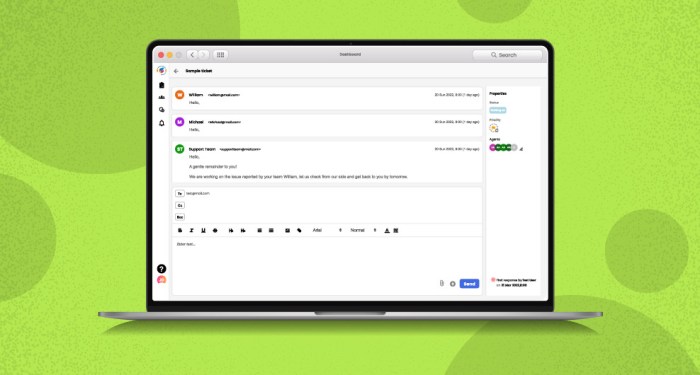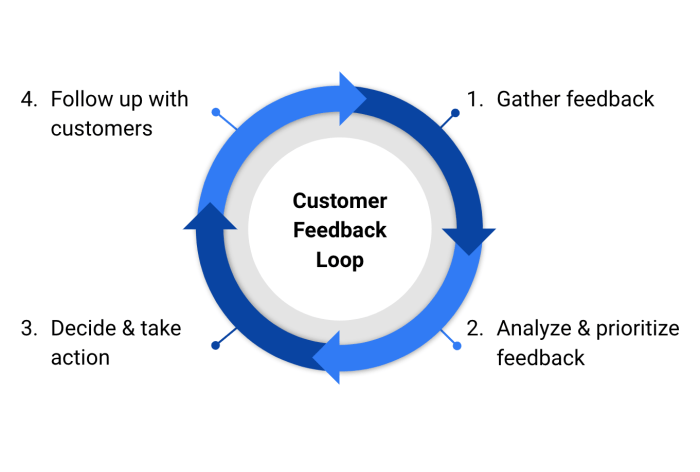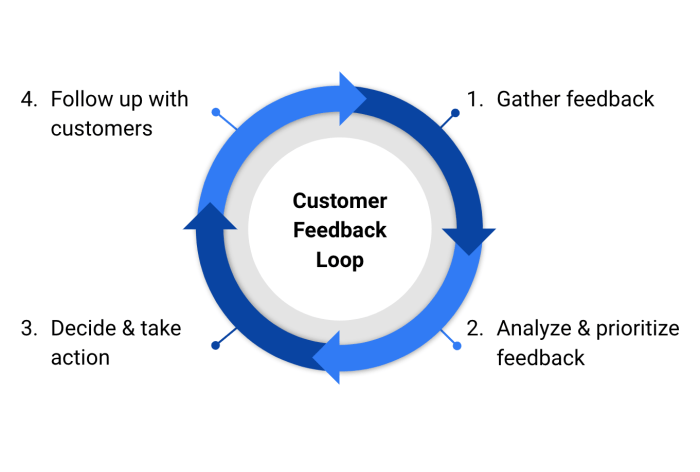Building a Customer Feedback Loop is the key to unlocking success in today’s competitive market. Dive into the world of feedback strategies and customer engagement with us as we explore the ins and outs of this essential business practice.
From understanding the importance of feedback loops to implementing effective systems, this journey will equip you with the tools needed to thrive in the feedback-driven landscape of modern business.
Importance of Building a Customer Feedback Loop

Establishing a customer feedback loop is crucial for businesses to gather valuable insights directly from their customers. It allows companies to understand customer needs, preferences, and pain points in order to make informed decisions and improve their products or services.
Benefits of a Well-Structured Feedback Loop
- Improved Customer Satisfaction: By listening to feedback, companies can address issues promptly and enhance the overall customer experience.
- Product Improvement: Feedback helps companies identify areas for product enhancement and innovation, leading to better offerings that meet customer expectations.
- Brand Loyalty: Engaging with customers through feedback loops can build trust and loyalty, as customers feel heard and valued by the company.
- Competitive Advantage: Companies that continuously gather and act on feedback are better positioned to stay ahead of competitors and adapt to market changes.
Examples of Successful Companies
Several successful companies have effectively utilized customer feedback loops to drive growth and improve customer satisfaction. One notable example is Amazon, which collects feedback from customers through reviews and ratings to enhance product offerings and the overall shopping experience. Another example is Starbucks, which regularly seeks feedback from customers to refine its menu and store layout based on customer preferences.
Strategies for Creating an Effective Customer Feedback Loop

Creating an effective customer feedback loop involves various methods and practices that can help businesses gather valuable insights from their customers.
Methods for Collecting Customer Feedback
- Surveys: Sending out surveys via email or on the website can help gather structured feedback from customers.
- Interviews: Conducting one-on-one interviews with customers can provide in-depth qualitative insights.
- Social Media Monitoring: Keeping track of social media platforms for mentions, comments, and reviews can give real-time feedback.
Importance of Setting Clear Objectives
Having clear objectives when designing a feedback loop is crucial to ensure that the feedback collected aligns with the business goals and objectives. It helps in focusing on specific areas that require improvement and allows for more targeted actions based on the feedback received.
Best Practices for Analyzing and Interpreting Feedback Data, Building a Customer Feedback Loop
- Utilize feedback tools: Use software and tools to organize and analyze feedback data efficiently.
- Look for trends: Identify recurring themes or patterns in the feedback to prioritize areas for improvement.
- Act on feedback: Take actionable steps based on the feedback received to show customers that their input is valued.
Implementing Feedback Loop Systems
Implementing a customer feedback loop within an organization is crucial for continuous improvement and customer satisfaction. Here are the steps involved in setting up an effective feedback loop system:
Choosing the Right Tools and Technologies
To support a feedback loop system, it is essential to choose the right tools and technologies that align with your organization’s goals and customer communication channels. Consider the following factors when selecting tools:
- Identify the channels: Determine where your customers are most active and choose tools that can collect feedback from those channels, whether it’s social media, email, or your website.
- Automation capabilities: Look for tools that offer automation features to streamline the feedback collection process and respond to customers in a timely manner.
- Analytics and reporting: Select tools that provide in-depth analytics and reporting functionalities to track feedback trends, sentiment analysis, and key performance indicators.
Examples of Software or Platforms
There are various software and platforms available that can assist in managing customer feedback effectively. Some popular examples include:
- SurveyMonkey: A widely used survey tool that allows organizations to create customized surveys to gather feedback from customers.
- Zendesk: A customer service software that includes a feedback management system to collect, organize, and analyze customer feedback.
- Medallia: A customer experience management platform that helps businesses collect and analyze feedback across multiple channels.
Engaging Customers in the Feedback Process: Building A Customer Feedback Loop
When it comes to building a successful customer feedback loop, engaging customers in the process is crucial. Here are some strategies to encourage customers to provide feedback willingly and maintain ongoing engagement:
Creating a User-Friendly Feedback System
One way to encourage customers to provide feedback is by creating a user-friendly feedback system. Make sure the process is simple, easy to access, and doesn’t take up too much of their time. This will make customers more likely to participate.
Offering Incentives or Rewards
Another effective strategy is to offer incentives or rewards for providing feedback. This could include discounts, coupons, or even entry into a giveaway. By giving customers something in return for their feedback, you motivate them to participate in your feedback initiatives.
Actively Seeking Feedback
Don’t wait for customers to come to you with feedback. Actively seek out their opinions by sending surveys, conducting polls, or even reaching out for one-on-one conversations. By showing that you value their feedback, you can maintain ongoing engagement throughout the feedback loop process.






